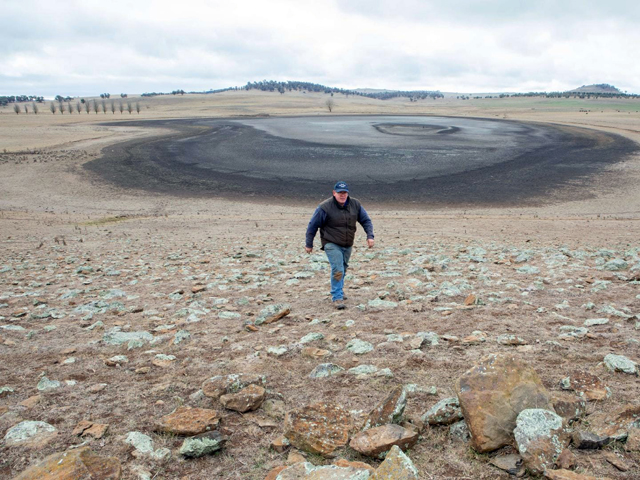Australia’s big dry is now its worst drought on record. Which is pretty much the way it is everywhere.

Following a lead from our state and federal governments, today I’m going to avoid the delicate matter of future climate. Instead I’ll focus on what’s happening around us now.
Weather records tell us that June in Australia was 0.26C warmer than average and 31 per cent drier. The first half of 2019 produced the continent’s second warmest and seventh driest conditions in 120 years of records.
In those six months the Murray-Darling Basin had about half its normal rainfall. Basin residents might have coped with this in normal times, but these are not normal times. Dry, warm, high-evaporation weather since January 2017 has left them with conditions they’ve not seen before.
Now it’s official. Rainfall records reveal that today’s Murray-Darling experience is Australia’s worst drought on record – more severe than the Federation, the World War II, the Millennium or any other drought in our recorded history.
Bureau of Meteorology climatologist David Jones told a BOM seminar last week that proxy evidence indicates Australia hasn’t been as dry as this for two or three million years, long before humans existed. This puts the current state of our weather in a completely new place.
Numerous NSW and southern Queensland towns now have emergency water restrictions in place. Many towns in upper Darling catchments calculate their water storage as a few months at most. In Tenterfield they’re pumping already-depleted groundwater to try to keep storage levels stable.
Water is now being carted to the small town of Guyra, 150 km away, but for Tenterfield that’s not an option – at least not a sustainable one. Its businesses and 4000 residents would need 1400 B-double truckloads a month, or nearly 50 each day, to sustain even minimal water use.
The list of towns threatened with losing their water supply is growing, including Warwick and Stanthorpe in Queensland. The larger centres of Tamworth, Armidale, Orange and Dubbo are lining up to join them if good rain doesn’t come this year. The Bureau is not hopeful of that happening.
Running out of water is a nightmare for any community. Cape Town almost ran out a year ago and is still in a tenuous position. In much-larger Chennai on India’s southeast coast, where it hasn’t rained for six months, the situation is dire. Monsoon rain is not expected for another month or two.
This city of 10 million people consumes over 500 million litres a day. The provincial government is now using trains to transport water every day from a half-full storage over 300 km away, but if the city were to run out completely that supply would have to increase 50-fold. That won’t happen.
Early monsoonal downpours in India’s Assam along with Nepal and Bangladesh have brought the opposite problem: too much water, displacing millions of people and killing over 100.
Not far away in the high Himalayas, the rate of glacier melt has been found to have doubled in less than 20 years to more than eight billion tonnes a year. A scientific assessment published in June is a very bad omen for downstream communities depending on glacial meltwater.
Meanwhile America’s Pacific north-west is preparing for another nasty fire season. A scientific wildfire survey has just informed Californians, after their worst season ever last year, that the state’s summer fires have increased five-fold since the 1970s, with rising temperature the key cause.
Wildfire anxiety has spread northward, to the dark, dank forests of British Columbia. The Canadian province’s wildfire service has warned that abnormally high fire conditions will be experienced in coastal regions including Vancouver Island at least till the end of summer.
This comes after several summers of intense wildfires up and down the Canadian west coast, mostly started by lightning strikes. They have been especially devastating in new-growth forests, where less genetic diversity and lower tree density allows higher moisture loss.
Things are hotting up in the far north. Alert, a Canadian military base on Ellesmere Island in the high Arctic, normally has a daytime maximum around 7C in July, but it’s currently experiencing an unprecedented heatwave that has seen temperatures climb above 20C.
Canada’s chief climatologist, David Phillips, says this heatwave is just the latest indicator of what will be a long, hot Arctic summer. The main trigger, say scientists, was a dramatic loss of Arctic sea ice over the past decade that allowed the ocean to absorb much more heat from the sun.
Smoke has become a regular contributor to Arctic weather, and this year is no exception. These are not forest fires so much as peat fires. The dried-out tundra itself is now burning in Alaska and across wide Siberian expanses, sending choking black smoke into the air.
Among the many things I’ve left out are Darwin’s groundwater crisis, depleted Great Barrier Reef coral, Europe’s unprecedented June heat (back again in July, especially in France), vanishing Antarctic sea ice, chronic drought in Africa and the Americas and floods in Asia, Africa and Latin America. Did I mention climate change?
• VICTIM of a chronic decline in government support, Hobart’s venerable environment and sustainability body, Sustainable Living Tasmania, has been forced to close its doors after nearly 50 years of quiet achievement. It will continue as a volunteer-run organisation with no office.
